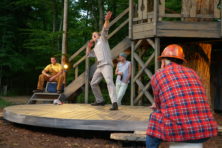‘Apologies to the King’: How ‘A Midsummer Night’s Dream’ Got Away with It
- Share
- Tweet
- Pin
- Share
If we shadows have offended,
Think but this, and all is mended,
That you have but slumber’d here
While these visions did appear.
Because of the immediate, physical nature of theater, its ability to deliver powerful messages directly to the audience is paramount. And because of its implicit interpretive nature, it’s common to see classic texts reimagined and adapted to fit the political climate of the modern time. Some examples include a feminist adaptation of The Taming of the Shrew and 2009’s West Side Story revival, with portions of dialogue and music rewritten in Spanish by Lin-Manuel Miranda to recontextualize some problematic elements of the original.
It’s important to keep historiography in mind when critically analyzing theater from centuries long gone. That is to say that the time, place and culture in which the play was written are all important elements to consider when reading a piece – but that isn’t to say that because of historical context, classical plays aren’t progressive. They may not be by today’s standards, but in their time, theater was perhaps the most controversially progressive medium around.
One way that playwrights were able to push the envelope safely – safety being key because when you perform for royalty, your life may very well be on the line – is through what I like to call “apologies to the king.”
Shakespeare wrote many of his works with the acute knowledge that the royal family would see them. This never made him shy away, however, from critiquing the royal family – or outright making fun of them – and the play that pushes against those boundaries the hardest is A Midsummer Night’s Dream.
Each of Midsummer’s twisting narratives upends social constructs or directly critiques the politics of the day in some way: the young lovers’ fluid sexuality in the forest, Titania and Bottoms’ short infatuation (the queen loves an ass) and, perhaps most pointedly, the farcical production of Pyramus and Thisbe put on by a ragtag theater troupe – a parody of Shakespeare’s own company – for the king and his new bride. All of these elements combine to create a piece that breaks boundaries left and right while pointing a finger directly at the royalty in the audience.
And yet Shakespeare was able to get away with this political commentary with a few short lines at the end of the play, when Puck the fairy takes center stage to directly apologize for what the audience has just witnessed.
This isn’t something that’s unique to Midsummer. A return to the status quo is something you see in most classical theater, and it may be the reason why we have access to these plays today in the first place. For a play to be preserved for hundreds of years, it must be both significant enough to warrant preservation – which usually meant it was performed at court – and unoffending enough to survive beyond its initial performance.
That isn’t to say that all surviving classical theater is safe – in fact, most was exceedingly progressive for its time – but a return to normalcy and an apology to the king are the mechanisms that allowed playwrights to push boundaries while ensuring that their art could live on. For a keen audience member, this should not undo the work that’s been done throughout the piece. Shakespeare may have performed his work for the king, but he wrote it for you.


